Abstract
Cellular levels of diadenosine tetraphosphate (Ap4A) were measured, by a specific high-pressure liquid chromatography method, in microplasmodia of Physarum polycephalum subjected to different degrees of hypoxia, hyperoxia, and treatment with H2O2. Ap4A levels increased three- to sevenfold under anaerobic conditions, and the microplasmodia remained viable after such treatment. Elevated levels of Ap4A returned to the basal level within 5 to 10 min upon reoxygenation of the microplasmodia. The increases in Ap4A levels were larger in stationary-phase or starved microplasmodia than in fed, log-phase microplasmodia. The maximal increase measured in log-phase microplasmodia was twofold. No significant changes in Ap4A levels occurred in microplasmodia subjected to mild hypoxia, hyperoxia, or treatment with 1 mM H2O2. These results indicate that in P. polycephalum, Ap4A may function in the metabolic response to anaerobic conditions rather than in the response to oxidative stress.
Full text
PDF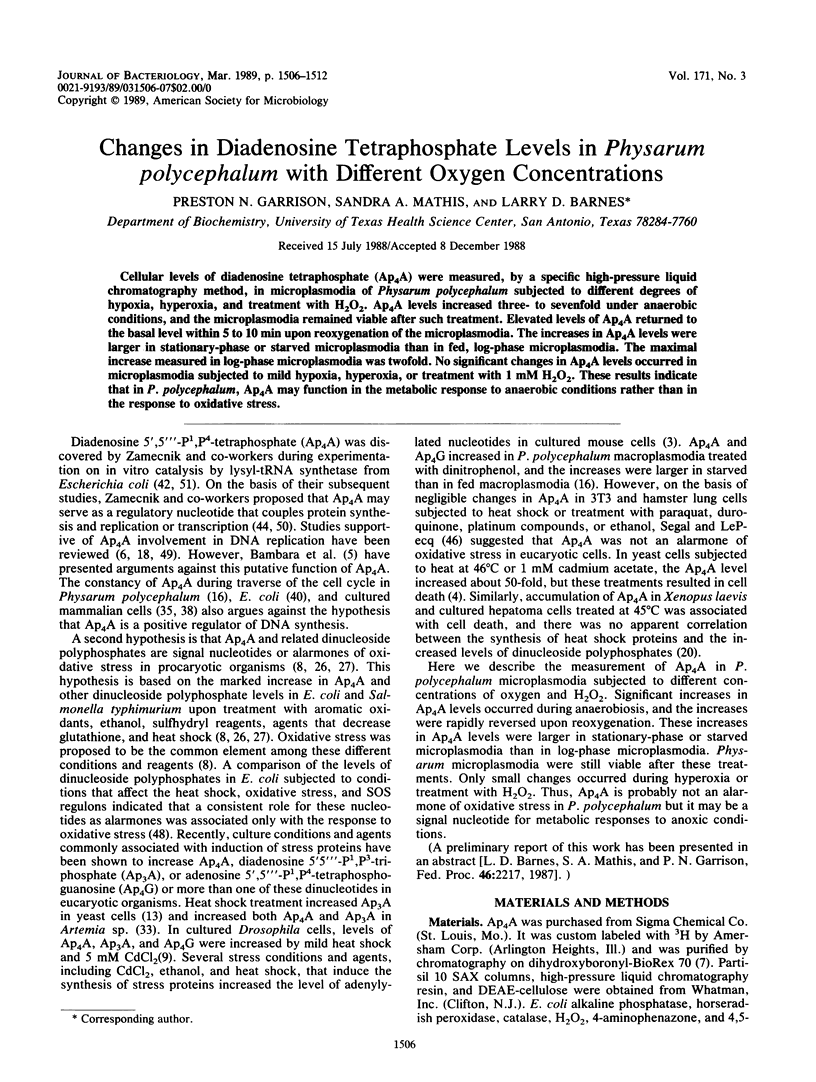
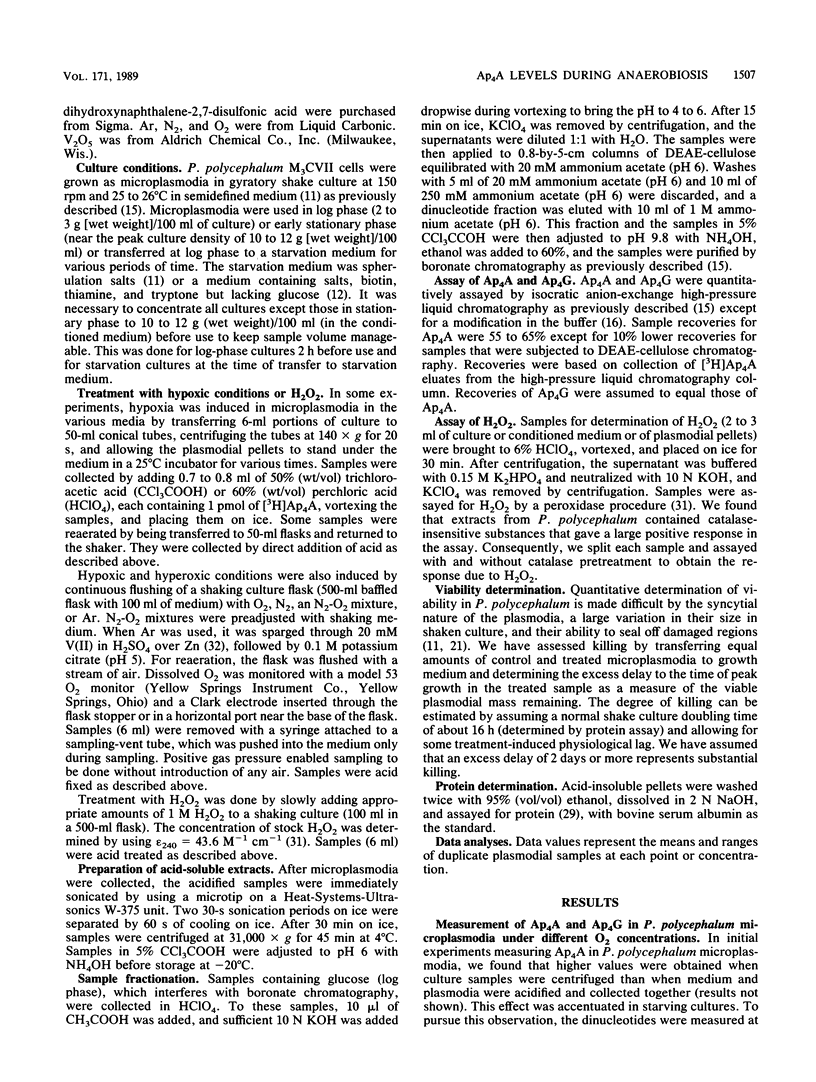
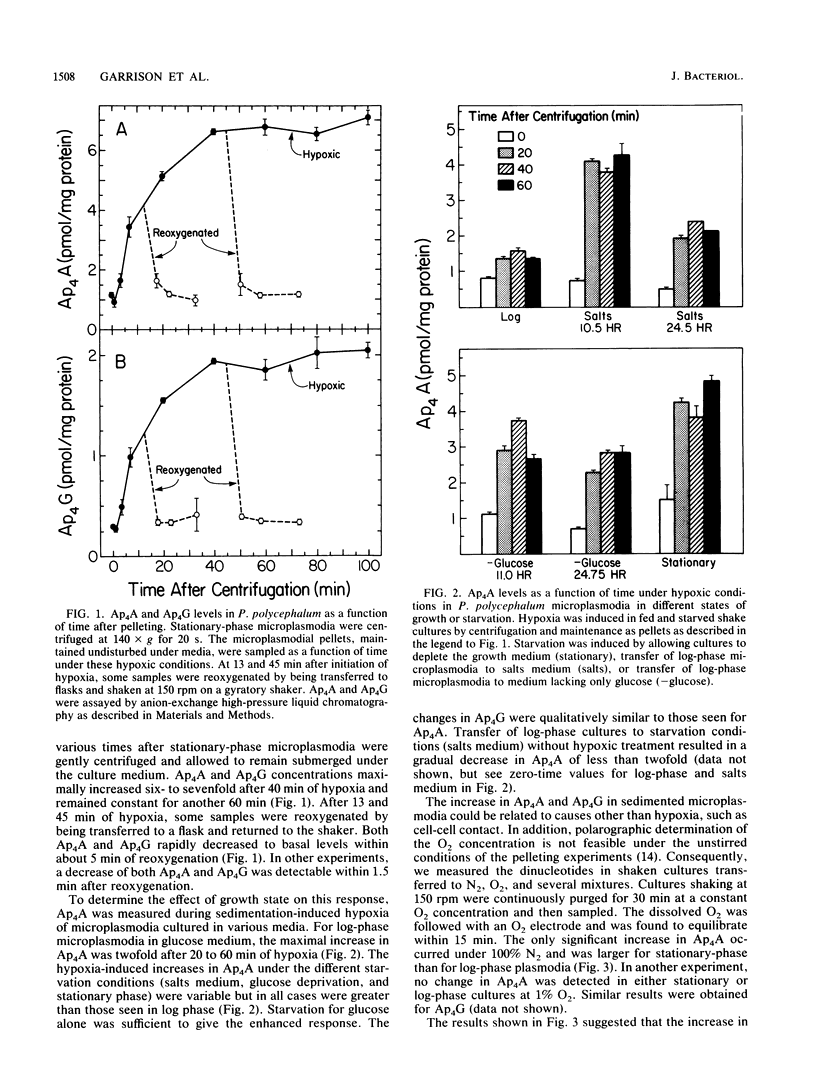
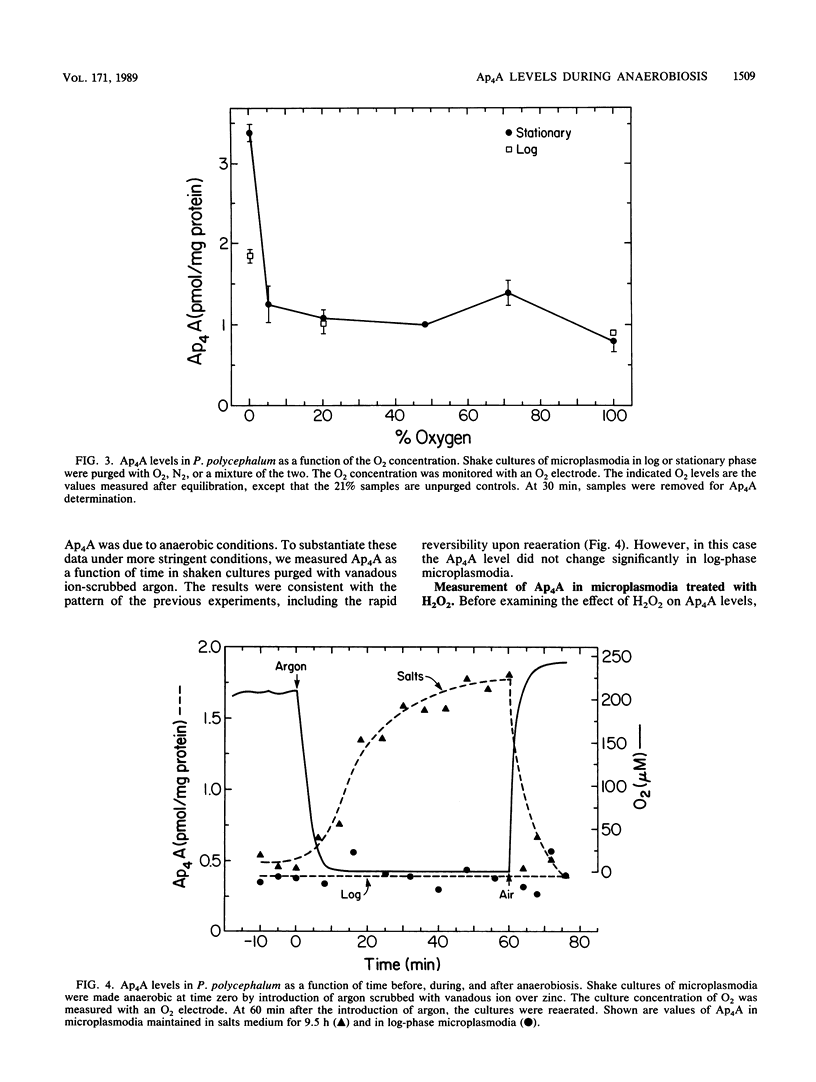
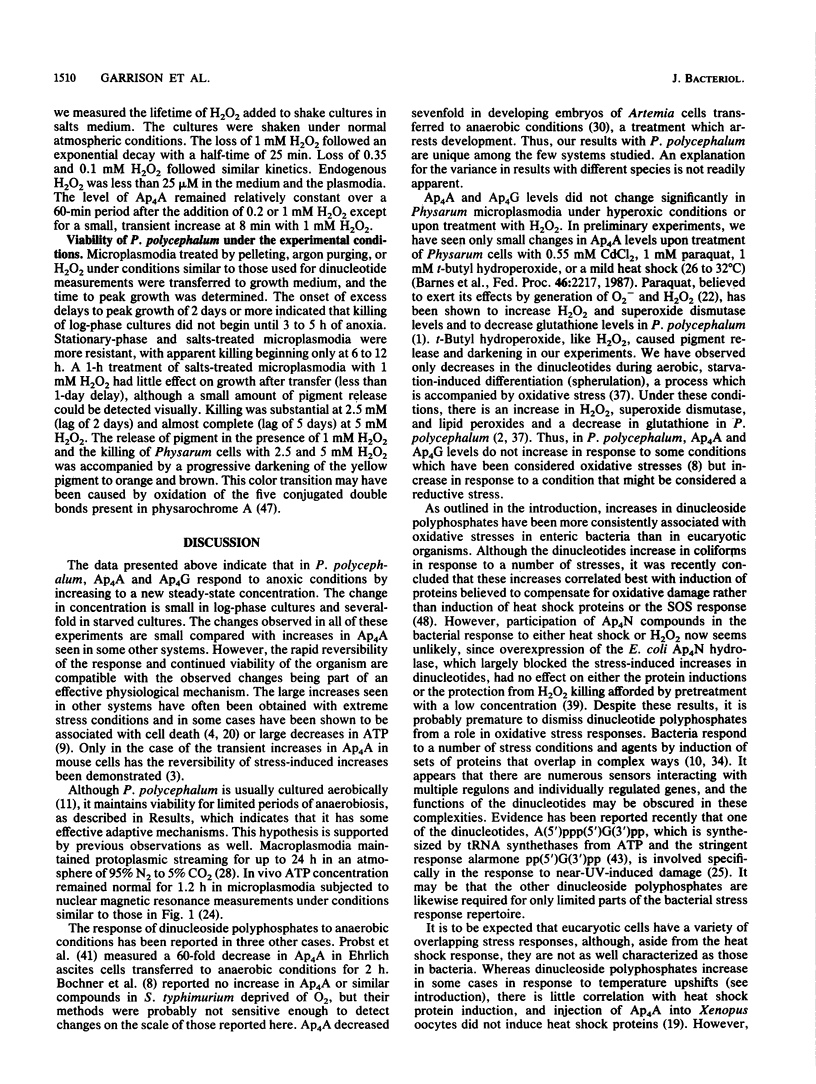
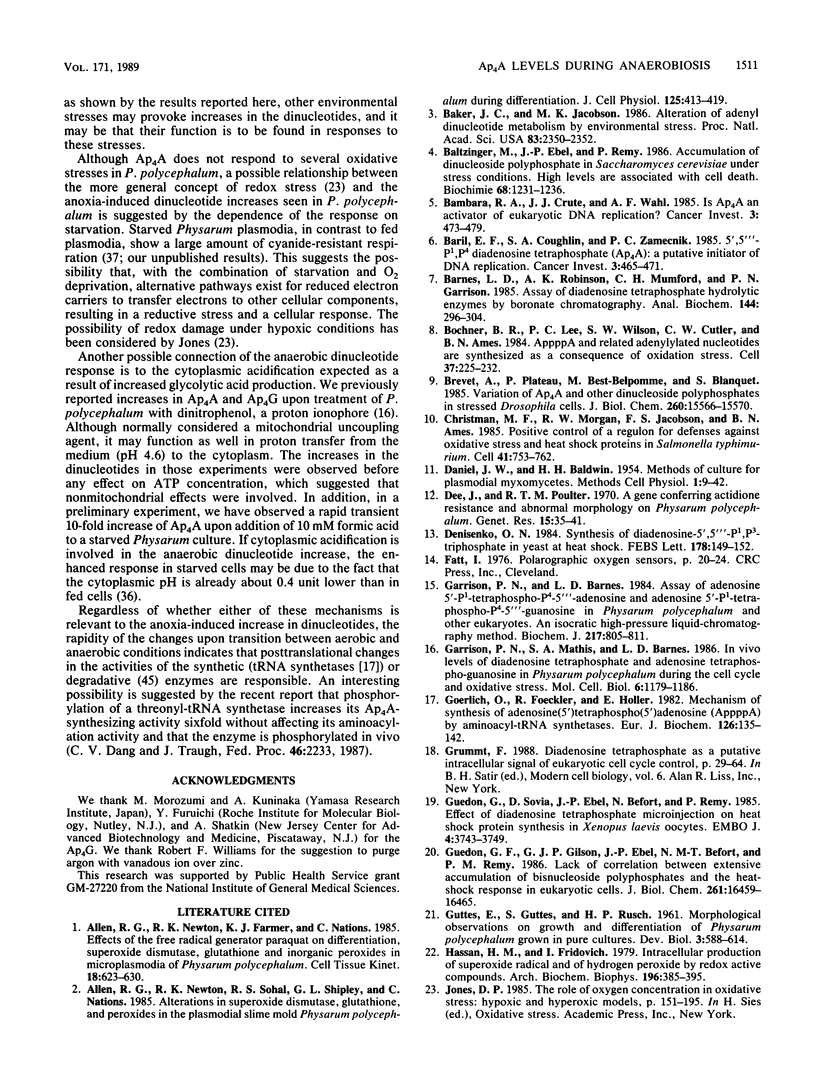
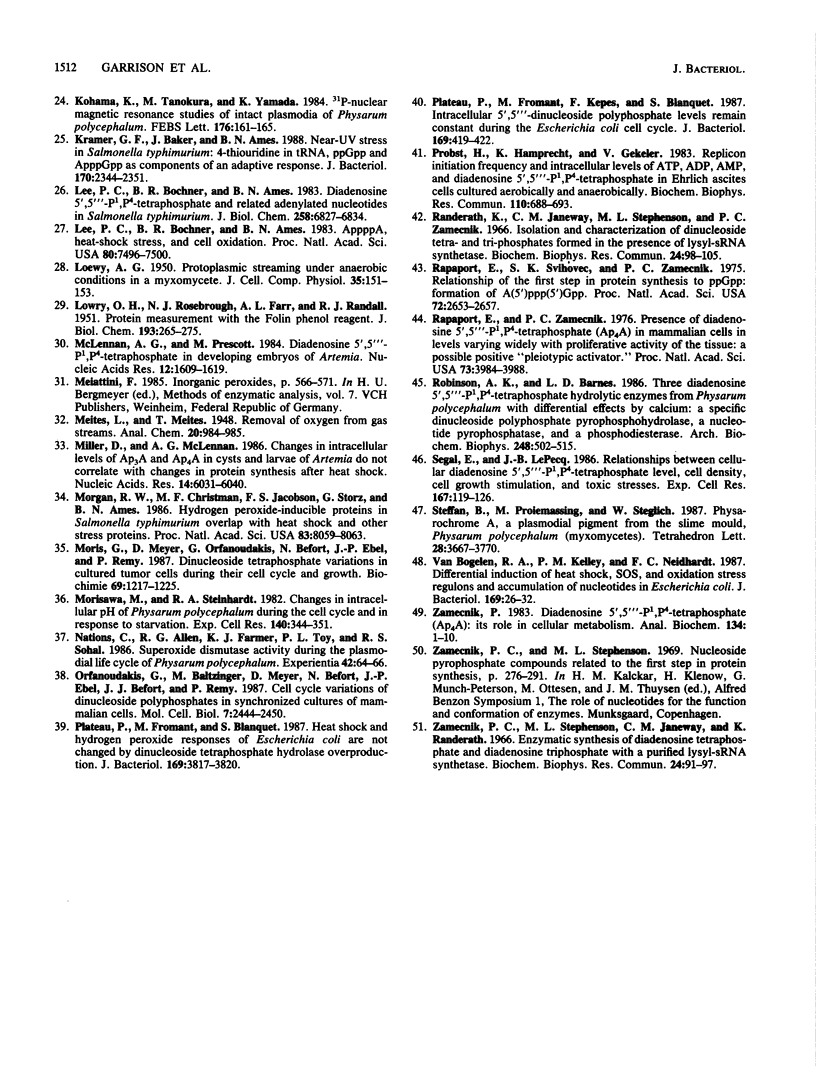
Selected References
These references are in PubMed. This may not be the complete list of references from this article.
- Allen R. G., Newton R. K., Farmer K. J., Nations C. Effects of the free radical generator paraquat on differentiation, superoxide dismutase, glutathione and inorganic peroxides in microplasmodia of Physarum polycephalum. Cell Tissue Kinet. 1985 Nov;18(6):623–630. doi: 10.1111/j.1365-2184.1985.tb00705.x. [DOI] [PubMed] [Google Scholar]
- Allen R. G., Newton R. K., Sohal R. S., Shipley G. L., Nations C. Alterations in superoxide dismutase, glutathione, and peroxides in the plasmodial slime mold Physarum polycephalum during differentiation. J Cell Physiol. 1985 Dec;125(3):413–419. doi: 10.1002/jcp.1041250308. [DOI] [PubMed] [Google Scholar]
- Baker J. C., Jacobson M. K. Alteration of adenyl dinucleotide metabolism by environmental stress. Proc Natl Acad Sci U S A. 1986 Apr;83(8):2350–2352. doi: 10.1073/pnas.83.8.2350. [DOI] [PMC free article] [PubMed] [Google Scholar]
- Baltzinger M., Ebel J. P., Remy P. Accumulation of dinucleoside polyphosphates in Saccharomyces cerevisiae under stress conditions. High levels are associated with cell death. Biochimie. 1986 Oct-Nov;68(10-11):1231–1236. doi: 10.1016/s0300-9084(86)80069-4. [DOI] [PubMed] [Google Scholar]
- Bambara R. A., Crute J. J., Wahl A. F. Is Ap4A an activator of eukaryotic DNA replication? Cancer Invest. 1985;3(5):473–479. doi: 10.3109/07357908509039809. [DOI] [PubMed] [Google Scholar]
- Baril E. F., Coughlin S. A., Zamecnik P. C. 5',5'''-P1, P4 diadenosine tetraphosphate (Ap4A): a putative initiator of DNA replication. Cancer Invest. 1985;3(5):465–471. doi: 10.3109/07357908509039808. [DOI] [PubMed] [Google Scholar]
- Barnes L. D., Robinson A. K., Mumford C. H., Garrison P. N. Assay of diadenosine tetraphosphate hydrolytic enzymes by boronate chromatography. Anal Biochem. 1985 Jan;144(1):296–304. doi: 10.1016/0003-2697(85)90120-4. [DOI] [PubMed] [Google Scholar]
- Bochner B. R., Lee P. C., Wilson S. W., Cutler C. W., Ames B. N. AppppA and related adenylylated nucleotides are synthesized as a consequence of oxidation stress. Cell. 1984 May;37(1):225–232. doi: 10.1016/0092-8674(84)90318-0. [DOI] [PubMed] [Google Scholar]
- Brevet A., Plateau P., Best-Belpomme M., Blanquet S. Variation of Ap4A and other dinucleoside polyphosphates in stressed Drosophila cells. J Biol Chem. 1985 Dec 15;260(29):15566–15570. [PubMed] [Google Scholar]
- Christman M. F., Morgan R. W., Jacobson F. S., Ames B. N. Positive control of a regulon for defenses against oxidative stress and some heat-shock proteins in Salmonella typhimurium. Cell. 1985 Jul;41(3):753–762. doi: 10.1016/s0092-8674(85)80056-8. [DOI] [PubMed] [Google Scholar]
- GUTTES E., GUTTES S., RUSCH H. P. Morphological observations on growth and differentation of Physarum polycephalum grown in pure culture. Dev Biol. 1961 Oct;3:588–614. doi: 10.1016/0012-1606(61)90034-3. [DOI] [PubMed] [Google Scholar]
- Garrison P. N., Barnes L. D. Assay of adenosine 5'-P1-tetraphospho-P4-5"'-adenosine and adenosine 5'-P1-tetraphospho-P4-5"'-guanosine in Physarum polycephalum and other eukaryotes. An isocratic high-pressure liquid-chromatography method. Biochem J. 1984 Feb 1;217(3):805–811. doi: 10.1042/bj2170805. [DOI] [PMC free article] [PubMed] [Google Scholar]
- Garrison P. N., Mathis S. A., Barnes L. D. In vivo levels of diadenosine tetraphosphate and adenosine tetraphospho-guanosine in Physarum polycephalum during the cell cycle and oxidative stress. Mol Cell Biol. 1986 Apr;6(4):1179–1186. doi: 10.1128/mcb.6.4.1179. [DOI] [PMC free article] [PubMed] [Google Scholar]
- Goerlich O., Foeckler R., Holler E. Mechanism of synthesis of adenosine(5')tetraphospho(5')adenosine (AppppA) by aminoacyl-tRNA synthetases. Eur J Biochem. 1982 Aug;126(1):135–142. doi: 10.1111/j.1432-1033.1982.tb06757.x. [DOI] [PubMed] [Google Scholar]
- Guedon G., Sovia D., Ebel J. P., Befort N., Remy P. Effect of diadenosine tetraphosphate microinjection on heat shock protein synthesis in Xenopus laevis oocytes. EMBO J. 1985 Dec 30;4(13B):3743–3749. doi: 10.1002/j.1460-2075.1985.tb04143.x. [DOI] [PMC free article] [PubMed] [Google Scholar]
- Guédon G. F., Gilson G. J., Ebel J. P., Befort N. M., Remy P. M. Lack of correlation between extensive accumulation of bisnucleoside polyphosphates and the heat-shock response in eukaryotic cells. J Biol Chem. 1986 Dec 15;261(35):16459–16465. [PubMed] [Google Scholar]
- Hassan H. M., Fridovich I. Intracellular production of superoxide radical and of hydrogen peroxide by redox active compounds. Arch Biochem Biophys. 1979 Sep;196(2):385–395. doi: 10.1016/0003-9861(79)90289-3. [DOI] [PubMed] [Google Scholar]
- Kramer G. F., Baker J. C., Ames B. N. Near-UV stress in Salmonella typhimurium: 4-thiouridine in tRNA, ppGpp, and ApppGpp as components of an adaptive response. J Bacteriol. 1988 May;170(5):2344–2351. doi: 10.1128/jb.170.5.2344-2351.1988. [DOI] [PMC free article] [PubMed] [Google Scholar]
- LOWRY O. H., ROSEBROUGH N. J., FARR A. L., RANDALL R. J. Protein measurement with the Folin phenol reagent. J Biol Chem. 1951 Nov;193(1):265–275. [PubMed] [Google Scholar]
- Lee P. C., Bochner B. R., Ames B. N. AppppA, heat-shock stress, and cell oxidation. Proc Natl Acad Sci U S A. 1983 Dec;80(24):7496–7500. doi: 10.1073/pnas.80.24.7496. [DOI] [PMC free article] [PubMed] [Google Scholar]
- McLennan A. G., Prescott M. Diadenosine 5',5'"-P1,P4-tetraphosphate in developing embryos of Artemia. Nucleic Acids Res. 1984 Feb 10;12(3):1609–1619. doi: 10.1093/nar/12.3.1609. [DOI] [PMC free article] [PubMed] [Google Scholar]
- Miller D., McLennan A. G. Changes in intracellular levels of Ap3A and Ap4A in cysts and larvae of Artemia do not correlate with changes in protein synthesis after heat-shock. Nucleic Acids Res. 1986 Aug 11;14(15):6031–6040. doi: 10.1093/nar/14.15.6031. [DOI] [PMC free article] [PubMed] [Google Scholar]
- Morgan R. W., Christman M. F., Jacobson F. S., Storz G., Ames B. N. Hydrogen peroxide-inducible proteins in Salmonella typhimurium overlap with heat shock and other stress proteins. Proc Natl Acad Sci U S A. 1986 Nov;83(21):8059–8063. doi: 10.1073/pnas.83.21.8059. [DOI] [PMC free article] [PubMed] [Google Scholar]
- Moris G., Meyer D., Orfanoudakis G., Befort N., Ebel J. P., Remy P. Dinucleoside tetraphosphate variations in cultured tumor cells during their cell cycle and growth. Biochimie. 1987 Nov-Dec;69(11-12):1217–1225. doi: 10.1016/0300-9084(87)90149-0. [DOI] [PubMed] [Google Scholar]
- Morisawa M., Steinhardt R. A. Changes in intracellular pH of Physarum plasmodium during the cell cycle and in response to starvation. Exp Cell Res. 1982 Aug;140(2):341–351. doi: 10.1016/0014-4827(82)90123-9. [DOI] [PubMed] [Google Scholar]
- Orfanoudakis G., Baltzinger M., Meyer D., Befort N., Ebel J. P., Befort J. J., Remy P. Cell cycle variations of dinucleoside polyphosphates in synchronized cultures of mammalian cells. Mol Cell Biol. 1987 Jul;7(7):2444–2450. doi: 10.1128/mcb.7.7.2444. [DOI] [PMC free article] [PubMed] [Google Scholar]
- Plateau P., Fromant M., Blanquet S. Heat shock and hydrogen peroxide responses of Escherichia coli are not changed by dinucleoside tetraphosphate hydrolase overproduction. J Bacteriol. 1987 Aug;169(8):3817–3820. doi: 10.1128/jb.169.8.3817-3820.1987. [DOI] [PMC free article] [PubMed] [Google Scholar]
- Plateau P., Fromant M., Kepes F., Blanquet S. Intracellular 5',5'-dinucleoside polyphosphate levels remain constant during the Escherichia coli cell cycle. J Bacteriol. 1987 Jan;169(1):419–422. doi: 10.1128/jb.169.1.419-422.1987. [DOI] [PMC free article] [PubMed] [Google Scholar]
- Probst H., Hamprecht K., Gekeler V. Replicon initiation frequency and intracellular levels of ATP, ADP, AMP and of diadenosine 5',5'''-P1,P4-tetraphosphate in ehrlich ascites cells cultured aerobically and anaerobically. Biochem Biophys Res Commun. 1983 Jan 27;110(2):688–693. doi: 10.1016/0006-291x(83)91204-4. [DOI] [PubMed] [Google Scholar]
- Randerath K., Janeway C. M., Stephenson M. L., Zamecnik P. C. Isolation and characterization of dinucleoside tetra- and tri-phosphates formed in the presence of lysyl-sRNA synthetase. Biochem Biophys Res Commun. 1966 Jul 6;24(1):98–105. doi: 10.1016/0006-291x(66)90416-5. [DOI] [PubMed] [Google Scholar]
- Rapaport E., Svihovec S. K., Zamecnik P. C. Relationship of the first step in protein synthesis to ppGpp: formation of A(5')ppp(5')Gpp. Proc Natl Acad Sci U S A. 1975 Jul;72(7):2653–2657. doi: 10.1073/pnas.72.7.2653. [DOI] [PMC free article] [PubMed] [Google Scholar]
- Rapaport E., Zamecnik P. C. Presence of diadenosine 5',5''' -P1, P4-tetraphosphate (Ap4A) in mamalian cells in levels varying widely with proliferative activity of the tissue: a possible positive "pleiotypic activator". Proc Natl Acad Sci U S A. 1976 Nov;73(11):3984–3988. doi: 10.1073/pnas.73.11.3984. [DOI] [PMC free article] [PubMed] [Google Scholar]
- Robinson A. K., Barnes L. D. Three diadenosine 5',5''-P1,P4-tetraphosphate hydrolytic enzymes from Physarum polycephalum with differential effects by calcium: a specific dinucleoside polyphosphate pyrophosphohydrolase, a nucleotide pyrophosphatase, and a phosphodiesterase. Arch Biochem Biophys. 1986 Aug 1;248(2):502–515. doi: 10.1016/0003-9861(86)90503-5. [DOI] [PubMed] [Google Scholar]
- Segal E., Le Pecq J. B. Relationship between cellular diadenosine 5',5'''-P1,P4-tetraphosphate level, cell density, cell growth stimulation and toxic stresses. Exp Cell Res. 1986 Nov;167(1):119–126. doi: 10.1016/0014-4827(86)90209-0. [DOI] [PubMed] [Google Scholar]
- VanBogelen R. A., Kelley P. M., Neidhardt F. C. Differential induction of heat shock, SOS, and oxidation stress regulons and accumulation of nucleotides in Escherichia coli. J Bacteriol. 1987 Jan;169(1):26–32. doi: 10.1128/jb.169.1.26-32.1987. [DOI] [PMC free article] [PubMed] [Google Scholar]
- Zamecnik P. C., Stephenson M. L., Janeway C. M., Randerath K. Enzymatic synthesis of diadenosine tetraphosphate and diadenosine triphosphate with a purified lysyl-sRNA synthetase. Biochem Biophys Res Commun. 1966 Jul 6;24(1):91–97. doi: 10.1016/0006-291x(66)90415-3. [DOI] [PubMed] [Google Scholar]
- Zamecnik P. Diadenosine 5',5"'-P1,P4-tetraphosphate (Ap4A): its role in cellular metabolism. Anal Biochem. 1983 Oct 1;134(1):1–10. doi: 10.1016/0003-2697(83)90255-5. [DOI] [PubMed] [Google Scholar]


